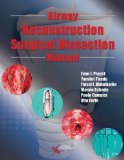Airway Reconstruction Surgical Dissection Manual

Author: Evan Propst, MD, MSc, FRCSC, Yamilet Tirado, MD, Faisal Abdulkader, BM, MSc, FRCS, Marvin Estrada, VT, Paolo Campisi, MSc, MD, FRCSC, FAAP, Vito Forte, MD, FRCSC
Affiliation: Hospital for Sick Children, Toronto & University of Toronto, Canada
Publisher: Plural Publishing
Publication Date: 2014
ISBN 10: 1597565725
ISBN 13: 9781597565721
eISBN: 9781597566643
Edition: 1st
Affiliation: Hospital for Sick Children, Toronto & University of Toronto, Canada
Publisher: Plural Publishing
Publication Date: 2014
ISBN 10: 1597565725
ISBN 13: 9781597565721
eISBN: 9781597566643
Edition: 1st
Description:
Otolaryngology-head and neck surgeons, general surgeons, and thoracic surgeons are required to know how to perform various types of open airway surgery. However, due to a decrease in the number of patients with subglottic or tracheal stenosis and resident work hour restrictions, exposure to these cases during training is often inadequate. As a result, there is an ever-increasing need for training programs to develop lifelike open airway simulation models. These in turn will promote competency-based surgical residency training and a drive toward continuing medical education and maintenance of certification.. Written by an international group of airway surgeons, Airway Reconstruction Surgical Dissection Manual is an essential guide for residents and fellows in the fields of otolaryngology-head and neck surgery, general surgery, and thoracic surgery, as well as consultant surgeons in these specialties who are responsible for managing airway conditions, but infrequently perform open airway surgeries.. This manual covers everything the trainee requires for mastering open airway surgical procedures on a live animal and extrapolating these techniques to human patients. It is extensively detailed for the beginner or for the experienced surgeon perfecting his or her technique, and can be used by the individual working at his or her own pace or in a group setting.. There are several key features to this text:. Complex tasks are broken into rudimentary steps so they can be mastered by trainees at any level High quality photos and diagrams of each surgical step convey information clearly and succinctly Procedural differences between animals and humans are clearly identified for easy and practical application to human patients.
Related Titles
